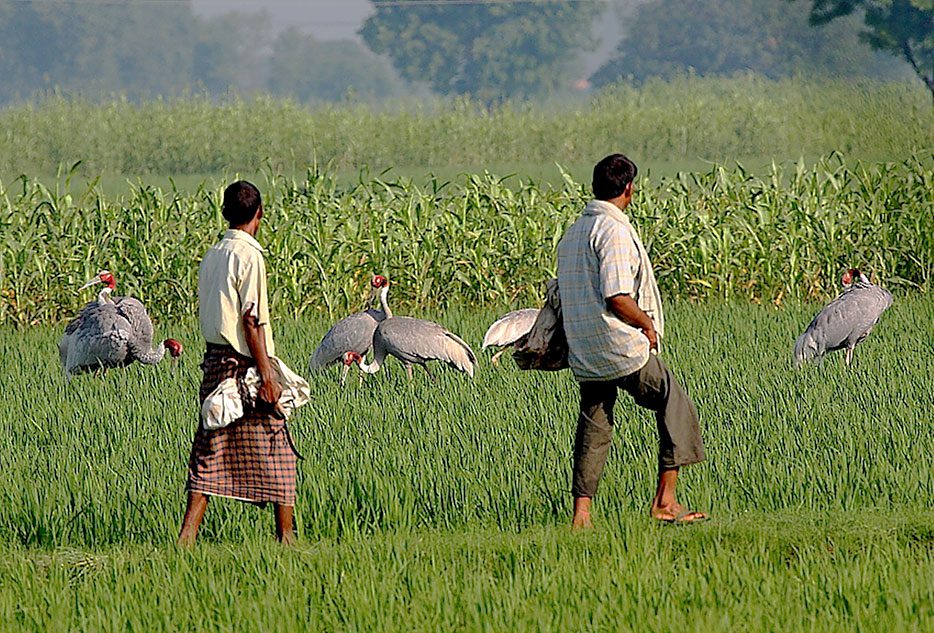In a Crowded India, Farmers and Sarus Cranes Coexist
By Lauren Chambliss
January 8, 2018

From the Winter 2018 issue of Living Bird magazine. Subscribe now.
It is hard to imagine a place less hospitable for cranes than the state of Uttar Pradesh in northeast India. Dominated by crowded urban centers and intense agriculture, Uttar Pradesh is geographically about the size of Michigan, and home to more than 200 million people—about the population of the United States east of the Mississippi River.
Typically, that’s not a good recipe for large wetland birds. Yet, in Uttar Pradesh, cranes are flourishing. To the surprise of crane scientists who conducted surveys here, the Sarus Crane—tallest of the world’s flying birds, listed as vulnerable on the International Union for the Conservation of Nature’s Red List—is feeding, nesting, and successfully raising young in rice paddies and wheat fields throughout this tightly packed agricultural landscape.


Worldwide, 11 of the 15 crane species are listed as either vulnerable or endangered on the IUCN Red List, so the prosperity of Sarus Cranes in Uttar Pradesh is a happy anomaly. In this northern Indian state that’s famous for the Taj Mahal, humans have managed to make room for cranes, even as people have developed nearly all of their natural habitat.
“Uttar Pradesh is 70 percent agriculture, 20 percent urban, and 10 percent scrubland, which is not usually a good landscape for wetland birds,” says Gopi Sundar, crane biologist with the Nature Conservation Foundation. Sundar initiated the first detailed crane survey in the area a decade ago and discovered a population 13,000 strong, and growing. With only around 25,000 Sarus Cranes in the entire world, the birds in Uttar Pradesh make up more than half the global population.
“What we found is astounding. A lot more cranes than we ever imagined, and they have been there for thousands of years,” Sundar says. Indeed, there are references to the relationship between Sarus Crane and people in Uttar Pradesh in the Ramayana, an epic poem from the 5th century B.C.
“Villagers and farmers not only tolerate them, but welcome them,” Sundar says. “People have evolved with the cranes.”
Sundar, who is also the director of Program Saruscape for the International Crane Foundation, credits cultural factors for the bird’s extraordinary success in the region. Villagers here believe the giant bird with the bright red head brings good fortune. In Etawah, a city perched on the banks of the Chambal River, it is believed that hearing a Sarus trumpet in the night means it is a propitious time to take action on a big life event, such as proposing marriage or making an investment.


Kailash Jaiswal, a 21-year-old local Hindu villager, remembers his father and grandfather telling him never to bother the three pairs of cranes that nested on their family’s 2.5 acre farm.
“Even if there was a small bit of damage in the field, we would just ignore it,” he recalls. “There was a belief that if a Sarus nests and breeds in your field, the output that year will be much higher.”
But Sarus Cranes are not so beloved everywhere. They construct large platform nests that can be the size of a kitchen table, and they often tear up entire rice stalks for building material, which can lead to farmer complaints and conflicts. Across the Sarus range—India, Southeast Asia, and Australia—there are few thriving populations. In Cambodia and Vietnam, Sarus have declined to only about 1,000 cranes in the wild.


But in Uttar Pradesh, the cranes are welcomed, and the seasonal rhythm of smallholder farming is a good fit for the crane’s life cycle. Most farmers employ rotational cropping systems of rice in the monsoon season (good crane nesting habitat) and wheat in the dry season (providing a year-round food source for cranes). Studies have shown that Sarus do better in rice and wheat fields than soy or sugar cane.
“The Sarus in India are similar to our Sandhill Crane in the United States in being largely adapted to living on agricultural lands,” says Richard Beilfuss, the CEO of the International Crane Foundation. Beilfuss points out that Sandhill Crane populations are recovering because they have adapted to eating grain in farmers’ fields—and because humans in the late 20th century were friendlier toward cranes, easing up on hunting and protecting breeding habitat through wetland conservation.
Likewise, on the other side of the world, Sarus Cranes are further proof that people and cranes can peacefully coexist.
“Sarus Cranes are a flagship for sustaining this diverse agricultural landscape,” says the ICF’s Beilfuss. “In India the species is living in harmony with people in one of the most densely populated areas of the world.”
Lauren Chambliss is a senior lecturer with Cornell University’s Department of Communication. A former economics correspondent for the London Evening Standard, she now teaches communication and writes about the environment and sustainability.


All About Birds is a free resource
Available for everyone,
funded by donors like you





